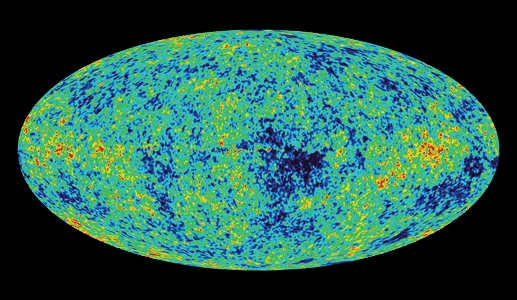Echoes from the Infant Universe
March 19, 2014
The first direct evidence in support of inflation theory, which holds that the universe expanded very rapidly in the first fraction of a second of its existence, has been reported by scientists. The discovery is being hailed as a major development in science. The evidence, announced by astronomers led by John M. Kovac of the Harvard-Smithsonian Center for Astrophysics, consists of spiral patterns in a faint bath of energy left over from the early universe. This energy is called the cosmic microwave background (CMB) radiation.
Scientists think that our universe began in a cosmic explosion—known as the big bang–some 13.8 billion years ago. A complementary idea, inflation theory, explains how space itself rapidly expanded just a fraction of a second after the universe began. This theory was developed by American physicist Alan Guth in the late 1970′s (see the special report Beyond the Big Bang, under Additional World Book articles below). The existence of the CMB radiation, discovered in the 1960’s, has long been cited as evidence for the big bang. Mathematical models predict that the big bang would have produced energy that cooled as the universe expanded. Scientists believe the CMB radiation is the very same ancient energy source.
But the CMB presents a puzzle of its own: It looks the same in every direction. The problem is that the universe is too big—and too young—for the CMB to have naturally “mixed” itself into such a uniform state. As a crude analogy, consider mixing cold and hot water. If you pour cold water and hot water into a teacup, it does not take long for the teacup’s water to become lukewarm throughout. But if you poured cold water and hot water from two mountains on opposite sides of North America, the two water sources might not ever even touch each other, let alone mix into lukewarm water. To mix together a uniform cosmic ocean of CMB radiation, in fact, would take much longer than 13.8 billion years, the predicted age of the universe.

A survey of the cosmic microwave background (CMB) radiation uses color to show slight variations in temperature. The resulting image reveals the universe's structure over 13 billion years ago. (NASA/WMAP Science Team)
Scientists developed inflation theory in the late 1970’s partly to explain the CMB’s puzzling uniformity. According to inflation theory, the earliest universe was microscopic and extremely dense. Then the universe experienced a sudden, tremendous period of expansion–the inflation. Inflation began and ended just a fraction of a second after the universe itself began. Afterward the universe continued expanding at a much slower pace. The CMB radiation is uniform, according to inflation theory, because its origins must lie in the “teacup-sized” pre-inflation universe, where energy could mix more easily.
The problem with inflation theory has been a lack of direct evidence. Inflation explains a cosmological puzzle, but scientists have not been able to detect its signatures—until now. Scientists took comprehensive measurements of the CMB’s polarization—that is, the way its waves of electromagnetic radiation twist or vibrate in different directions. The scientists used a set of detectors near the South Pole called BICEP2. (BICEP is short for Background Imaging of Cosmic Extragalactic Polarization). If inflation occurred as predicted, the sudden violence of the expansion would have created ripples of gravitational energy. These gravitational waves, in turn, would have left distortions in the CMB radiation. Analyzing the data from BICEP2, scientists discovered exactly these distortions–spiral patterns in the CMB’s polarization that could only be explained by gravitational waves from inflation. The findings make a strong case for inflation theory and round out our understanding of the big bang.
Additional World Book articles:
- Astronomy
- Cosmology
- Planck
- Beyond the Big Bang (a Special Report)
- The Formation of Galaxies and Other Structures (A Special Report)
- The History of Cosmology (a Special Report)


